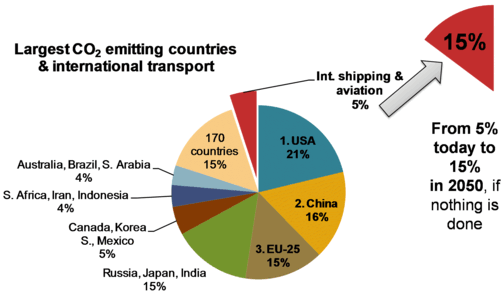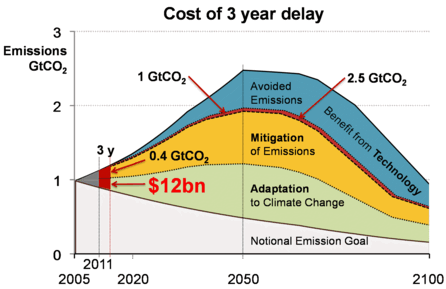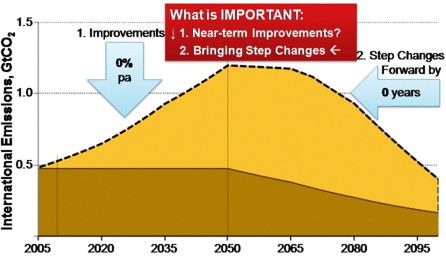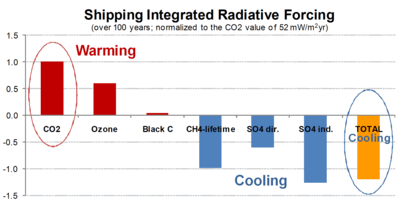Case for (affordable) Action
 International maritime CO2 emissions accounts “only” for circa 3% of total emissions from fossil fuels. They are #6*, if compared with the largest emitting nations. Their share can more than double by 2050.
International maritime CO2 emissions accounts “only” for circa 3% of total emissions from fossil fuels. They are #6*, if compared with the largest emitting nations. Their share can more than double by 2050.
Action to reduce shipping CO2 emissions and contribute to tackle climate change can be ambitious yet affordable.
* Based on the most recent estimates from 2007 of circa 0.9GtCO2 (maritime emissions are now #6 after emissions from the United States, China, Russian Federation, Japan and India).
International emissions are exempt from taxes, and unaffected by the Kyoto Protocol.
If nothing is done, the total emissions from international maritime transport and aviation will in 2050 reach 15% of all emissions from fossil fuels. This will in effect triple their current share estimated at 5% as shown below. The pressure for action is therefore growing very rapidly (see for instance a recent article on: True scale of C02 emissions from shipping revealed). It seems unavoidable that both maritime and aviation must contribute to global emission reductions.
In short, emissions from international transport are far from small, and grow rapidly ....
Case for Affordable Action
The shipping should contribute fairly to action on global warming, and it could be done in an affordable manner. The arguments for a flexible and lowest cost approach for shipping are numerous. Shipping is:
- the most efficient mode of transport and has a very low energy consumption
- vital to economic growth, as it is responsible for more than 90% of volume of goods transported internationally
- having a cooling effect rather than a warming one on the world climate
Cost of delay
Delaying action is very expensive. Based on our calculations, shown below, the environmental cost of 3 year delay is estimated at excess of 1.4 - 1.8 GtCO2 by 2050 alone. This is equivalent to 1.5 years of maritime emissions.
The cost of delay to the developing countries is $12bn of financing for adaptation to climate change not made available.

Note: calculations for 20-50 emission goal from 2005 baseline.
Details will be unveiled in Bonn in mid June 2008. Calculations for slightly different different assumptions are available in the Case for action discussion document ![]() (0.2 MB) originally prepared for the IMO MEPC 56 in July 2007.
(0.2 MB) originally prepared for the IMO MEPC 56 in July 2007.
An ambitious yet affordable reductions are achievable
- Shipping could and should:
- adopt as soon as possible an ambitious, long-term notional emission reduction target, and align it later once the post-2012 climate change regime is agreed
- invest in the cheapest short-term emission reductions (very likely to be primarily outside of shipping for the reasons above)
- invest in the long-term reductions in the sector itself.
Mitigation*2
Maritime Technology Fund or similar is needed
 Both near-term and long-term emission reductions are especially needed in maritime transport due to long lifetime of ships and their engines (symbolized by the mitigation*2 title).
Both near-term and long-term emission reductions are especially needed in maritime transport due to long lifetime of ships and their engines (symbolized by the mitigation*2 title).
Significant total emission reductions will only come with deployment of technology breakthroughs/transformations, such as hydrogen transport. At the same time investment in maritime Research & Design has been declining in recent years.
Investing in bringing forward transformations has major benefits
Simulations clearly show the great importance of bringing forward the step changes called for by IMERS, as animated below (after about 3 seconds).

Cooling effect of shipping
Additional Note: Cooling Effect of Shipping (case for action)
[We prefer to discuss the cooling effect head on rather than leave it aside ...]
Cooling is exerted through reduced methane (CH4) lifetime and atmospheric aerosols effects and has been recently quantified. The most comprehensive study on Climate forcing from the transport sectors has been published by Jan Fuglestvedt, Terje Berntsen, Gunnar Myhre, Kristin Rypdal, and Ragnhild Bieltvedt Skeie (Norway, CICERO Institute) in the respected Proceedings of the National Academy of Sciences of the USA (PNAS; as an open access article). A summary is available at CICERO.
To illustrate the effect for shipping a graph depicting an integrated radiative forcing is shown, as per data kindly provided by the authors. The radiative forcing is integrated over 100 years to fully take into account the long warming impact of CO2 (as per the IPCC recommendations). The impacts are shown for CO2, ozone (O3), black carbon (soot; BC), reduced methane lifetime, and sulphate (CH4). CO2, Ozone and Black carbon have warming effect (shown in red). Reduction of CH4-lifetime, SO4 direct and indirect impacts have cooling effect (in blue). The overall, integrated effect from shipping is of cooling.
Cooling effect of shipping
To further clarify, the integration over 100 years took into account the significantly different lifetimes of different gases. Integrating over a shorter period would increase the cooling value. The impacts are driven by emissions of CO2, NOx, SO2, CO, Voluntary Organic Compounds (VOC), BC and organic carbon (OC) and complex atmospheric processes. Excluded from the graph are very small values for emissions of CH4, N20 and OC.
Cooling effect cannot be used to advocate inaction by shipping
The science behind the radiative forcing is complex and uncertainties regarding the direct and indirect aerosols effect are largest for shipping. Also, NOx and SOx have other impacts that damage environment, especially locally.
Instead of delaying any decisions, a flexibility is needed that would allow to reduce CO2 emissions where it is cheapest and makes the biggest impact. If hard and significant GHG emission reductions were somehow enforced on shipping a double whammy might follow.
Adaptation
The gap in funding is very big: 100:1
 This is the gap for financing adaptation to climate change in developing countries.
This is the gap for financing adaptation to climate change in developing countries.
Thus far the total funding for adaptation measures includes around $200 millions of donor funding plus few hundred $millions from the 2% levy on CDM projects. Required funds are estimated at tens of $billions per annum.
The UNFCCC 2007 project on Investment and Financial Flows to Address Climate Change ![]() highlighted both the scale of funds required and the need for innovative financing for adaptation
highlighted both the scale of funds required and the need for innovative financing for adaptation ![]() (0.2 MB). IMERS is such an innovative proposal for international maritime transport, that puts a carbon on shipping emissions, with no burden on developing countries.
(0.2 MB). IMERS is such an innovative proposal for international maritime transport, that puts a carbon on shipping emissions, with no burden on developing countries.
A share of net revenue raised that could be directed to adaptation alone is estimated in excess of $4bn annually.
At a time when there is a substantial mismatch between funds raised and required for adaptation the advantages and financing scale of IMERS cannot be ignored.
Case for Rebate Mechanism
In evaluating a design of a measure aiming to resolve equity issues of action on climate change in international shipping it is useful to review why the issue has proved both so important and challenging over the last 15 years. Thus we describe a short background, and then discuss why the current government proposals are unlikely to successfully address the equity issue.
Background
Various proposals for a Market Based Measure (MBM) for greenhouse gas (GHG) emissions from international shipping aim to address one or two complex challenges facing the international community.
First is how to cost-effectively reduce GHG emissions from international shipping. These emissions are large – more than double the emissions from international aviation, and greater than the entire emissions from the sixth most polluting country (Germany). They are not covered under the Kyoto Protocol, and creating a global solution to reduce them has thus far failed.
The second challenge is how to scale-up financing for climate change action, particularly for adaptation to climate change. Current financial mechanisms aimed at helping the world’s poor deal with the consequences of global warming are inadequate in both scale and predictability. The adaptation needs of developing countries are estimated at tens of $billions per annum. These needs are widely recognized.
Both challenges require solutions respecting equity, both between countries and between actions by different transport sectors. They may also require unprecedented global cooperation.
The vision to address these two challenges simultaneously was created in early 2007, in a proposal for an International Maritime Emission Reduction Scheme (IMERS). It led to and influenced various MBM submissions to the International Maritime Organization (IMO), and the United Nations Framework Convention on Climate Change (UNFCCC) (such as IMO 2007a, IMO 2008, UNFCCC 2008).
In the Copenhagen Accord of 2009, political leaders agreed that scaled-up, additional, predictable and adequate funding shall be provided to developing countries, in accordance with the relevant provisions of the UNFCCC. In the context of meaningful mitigation actions and transparency on implementation, developed countries committed themselves to a goal of jointly mobilizing US$100 billion a year by 2020 to address the needs of developing countries.
The High-level Advisory Group on Climate Change Financing (AGF), established by the Secretary-General of the United Nations, concluded in 2010 that it is challenging but feasible to meet this goal. Funding will need to come from a wide variety of sources, public and private, bilateral and multilateral, including alternative sources of finance.
Without underestimating the difficulties that will have to be solved, particularly in terms of national sovereignty and incidence (cost burden) on developing countries, the AGF pointed at carbon pricing of international transport as an important potential source for climate financing (and mitigation) that could contribute substantially towards mobilizing US$100 billion (AGF 2010).
The various proposals submitted to the IMO to reduce greenhouse gas (GHG) emissions from international shipping thus far are opposed by developing countries. They insist that the UNFCCC principle of common but differentiated responsibilities and respective capabilities (CBDR) must apply in the IMO. It requires rich nations to take the lead on climate action, based upon their historical contribution to the amount of greenhouse gases in the atmosphere.
The failure of the international community to apply CBDR for international transport for over 15 years combined with the fact that an effective regime must apply to all ships irrespective of flag, has resulted in a deadlock between developed and developing countries. The conundrum is how to make a shipping scheme both global (as per the IMO) and differentiated (as per the UNFCCC), and thus find a new approach that is politically acceptable to both developed and developing countries.
Our solution specifically focuses on how to eliminate the cost burden on developing countries from a potential MBM, and has emerged through an iterative design and negotiation process. The solution centres around a novel rebate mechanism to reconcile the principle of CBDR, on the country level, with the application of an MBM to all, on the ship level. The novelty also comes from using a country’s share of imports by value as the key to eliminate the above cost burden. These are integrated with the third generation of IMERS.
Current MBM proposals versus CBDR
It is useful to consider the current government proposals for a potential MBM vis-à-vis equity and the CBDR principle.
It is generally agreed that any MBM for international maritime transport should be global and apply to all ships irrespective of the flag they fly, inter alia, in order to avoid evasions and competitive distortions. All MBM proposals submitted to the IMO assume application to all ships. Some proposals consider disbursing the majority of the revenue raised to climate change action in developing countries. The discussions at the IMO and UNFCCC have shown that such an approach is not generally perceived by developing countries as fulfilling the UNFCCC principle of CBDR. It became clear that the heart of the matter is “who really pays” for the MBM.
Assuming a global application of an MBM, the cost incurred by the shipping industry will be passed on to end-consumers and producers, in both developed and developing countries. Effectively, some developing countries will therefore carry a share of the burden of the MBM, unless every developing country gains more than the total cost burden of the MBM to its economy. In this context, arguably, none of the government proposals so far truly incorporate the principle of CBDR, regardless of their revenue raising potential.
Consider an example where the majority of the MBM revenue raised is spent on purchasing emission credits from the Clean Development Mechanism (CDM) in developing countries, in order to offset maritime emissions. The proposal for a GHG Fund is an example of such an approach. In this scenario, many developing countries would in fact carry a share of the MBM burden as they would receive less than their cost incurred.
The reason is that an overwhelming majority of CDM projects are concentrated in just a few countries. Many developing countries, especially smaller ones, would therefore be net contributors to the generated funds, rather than being their beneficiaries. The funds would go to the larger, often more advanced developing countries. This is at odds with both the equity and CBDR principle. It is also against the UNFCCC obligations and commitments of developed countries to provide climate financing.
Broadening the revenue disbursement to other categories, such as adaptation and forestry, is unlikely to resolve the equity issue. First, as recent negotiations suggest, the opposition of developing countries to raising financing from all countries is based on fundamental principles, and thus is likely to remain strong. Second, even though some countries or their groups may become net MBM beneficiaries, others would not. The opposition from poor countries that anticipate a significant cost burden, and no benefits, is likely to remain strong
Why IMERS?
 The proposed differentiated levy on fuel for international shipping seems to be the least controversial way to raise significant financing for climate change. It complies with international laws and with principles of both the IMO and the UNFCCC, and it addresses international activity. IMERS and the novel cap-and-charge approach have been created to address major challenges of traditional market-based schemes for international shipping.
The proposed differentiated levy on fuel for international shipping seems to be the least controversial way to raise significant financing for climate change. It complies with international laws and with principles of both the IMO and the UNFCCC, and it addresses international activity. IMERS and the novel cap-and-charge approach have been created to address major challenges of traditional market-based schemes for international shipping.
For more than a decade numerous unsuccessful attempts have been made to create a market-based scheme to address growing greenhouse gas (GHG) emissions from transport sources, especially from international aviation and maritime transport. Emissions trading, mainly the cap-and-trade schemes have been widely suggested but have proved so far unsuited, especially for international transport.
Furthermore, in our humble view, the cap-and-charge is best suited to deliver on the Global but Differentiated principle & policy for shipping and climate change.
Six challenges of GHG cap-and-trade for transport
- Lack of reliable emission data: quality emission data that is needed to start a traditional market-based emission reduction scheme is not available for transport while acquiring such data is very costly and time consuming;
- Methodological obstacles: significant difficulties to allocate emission fairly and high operational costs are the major issues;
- Inadequate consideration of long-term actions and benefits: near-term actions are not expected to dramatically reduce transport emissions. Thus far the proposed approaches have failed to incorporate sustained long-term investments in low-emission technology R&D;
- Differentiated priorities of developing countries not reflected: all attempts to reduce emissions from international transport have considered some participation of developing countries in emission mitigation but none considered their acute needs to adapt to climate change. These two agendas were seen, discussed and treated separately;
- Non-GHG impacts of transport emissions ignored: all attempts to create market-based schemes have focused so far on the CO2 impacts, even though the non-GHG effects are of the same order of magnitude as CO2 for aviation and shipping;
- Lack of novel integrated approaches to eliminate existing issues of cap-and-trade while simultaneously bringing additional value to secure global participation. The emerging markets for emission credits are not seen as an enabler for new schemes but rather as a goal in themselves.
Cap-and-Trade Challenges Addressed
Challenge 1: Lack of reliable emission data for transport
Reliable emission data even in aggregated form is generally not available for a transport sector. Controversies exist not only for the future emissions but even for an emission value in a given past year, called an emission baseline. The estimates for emission baselines vary widely, for international maritime by as much as by a factor of two.
Yet reliable emission data is the major prerequisite for all thus far proposed market-based schemes to reduce emissions (apart from the fuel tax). The crash of the carbon market within the European Union Emission Trading Scheme (EU ETS) in 2006 made the requirement for accurate emission data for cap-and-trade undisputable. One year later the carbon price was about 1% of the level from before the crash.
Risk of starting cap-and-trade schemes without reliable data is very high. Such schemes are useless until accurate information on emissions becomes available. Obtaining accurate information for thousands of small mobile emitters is expensive and can take years to complete. It might even be unrealistic to achieve, due to the cost, commercial sensitivities, and complexity of enforcing such data collection internationally.
Challenge 2: Methodological obstacles
In nearly all attempts, a quantity-based scheme was preferred over a price-based one. The quantity scheme sets the limit on emissions and lets the market decide the price for emissions. The price scheme sets the price for emissions and leaves the market forces to drive down emissions. The quantity-based schemes are often called cap-and-trade, as a quantity emission cap is defined for each participant, emission allowances are allocated or auctioned to participants, and are subsequently traded on emission markets, such as the EU ETS.
- Apart from the lack of reliable emission data several major methodological issues are widely reported for applying cap-and-trade schemes to transport. These include:
- huge methodological and political issues to attribute emissions happening over high-seas to countries, or otherwise;
- significant difficulties to distribute the emission allowances to participating transport entities within the countries, or similar, in a way that does not change their competitive positions;
- administration costs are likely to be high due to the relatively small size and mobility of transport emitters;
- scheme coverage is likely to be significantly less than 100% as large number of the smallest emitters below the minimum emission threshold are excluded;
- the scheme alone will not materially reduce net emissions in the sector.
Even if total emissions were allocated to countries, routes or flags, it would be very difficult to distribute fairly the emission allowances, or caps, to participating entities. For instance, a grandfathering approach based on historical emissions will penalize entities that have already become very efficient through previous investments in emission reductions, while rewarding inefficient entities by allocating them relatively high emission quotas. Conversely, benchmarking will have the opposite effect rewarding already efficient participants and penalizing inefficient ones, but could only be implemented if and when a reliable benchmark is created and recognized. Creating a commercially suitable emission benchmark or benchmarks is a great challenge for global shipping due to its complexity, large number of ship types and sizes, and variety of business models. Creating an emission benchmark is further made difficult by the likely opposition from inefficient entities that will oppose providing any performance related data on the ground of commercial sensitivity, or otherwise.
Another major issue is the high transaction costs of cap-and-trade for small emitters, and high administration costs due to large number of them. The cost is increased for complex and dynamic business relationships in transport. For instance, in shipping the fuel costs can be paid by different parties and companies typically operate ships under several flags. Therefore, additional transactions and multiple reporting would be required. There is a risk that for some participants the operational costs could exceed the price of emission allowances themselves, as was the case for small stationery emitters in Europe in 2006 when the emission price was very low. Additional problem is that the greater the additional costs to participants the greater the risk of non-compliance.
Several so called up-stream variants have been discussed to reduce the number of participating entities but none have proved practical yet. They considered regulated entities being fuel suppliers or ship producers. The fuel suppliers could be required to hold emission permits to cover the life-cycle emissions of all the fuel they sell. They could reduce emissions directly by switching to lower-emission fuels or indirectly by buying emission permits from other sectors. The other option would be to regulate ship manufacturers. In such a scheme it would be necessary to estimate the lifetime emissions from ships they sell rather than base regulation on actual emissions. The manufacturers could reduce emission directly by producing more efficient vehicles or indirectly by buying the emission permits.
Scheme coverage and therefore theoretical effectiveness of cap-and-trade for transport will likely be significantly less than 100%. The requirement to participate in cap-and-trade scheme is most often defined by an emission threshold. Emitters with emissions below that threshold are not required to participate in the scheme. For instance, for industrial installations in the EU ETS this participation threshold is set at 10 MtCO2 per annum. If a similar threshold were applied to sea going ships a majority of them will need to be excluded. In practice, the ship participation threshold should actually be higher due to their mobility and increased administration costs when compared with stationery industry installations. This questions effectiveness of such a cap-and-trade scheme.
Challenge 3 - Long-term actions and benefits
The existing approaches focus on current or near-term emission mitigations only. Although the imperative of technology-enabled breakthroughs (transformations) is acknowledged they are politically and financially unattractive as they are decades away in transport. The level of investments that could bring forward the transformations, such as hydrogen transport, are inadequate.
- At the same time there is a growing recognition that the cap-and-trade schemes alone:
- will not materially reduce net emissions in international transport;
- will not stimulate the required long-term innovation.
International transport especially is characterized by low price elasticity of demand. Consequently, insignificant price increases will not materially reduce demand and therefore emissions. It is anticipated that the impact of cap-and-trade schemes on price of transport would be small at around 2%-3%. A weekly fuel price fluctuation is often greater than this margin so the impact of the additional emission costs on demand will be negligible. For instance, in 2007 the cost of bunker fuels has increased by about 60% without any material reduction of demand for international transport.
Even if the price impact is much higher than 3%, net emission reduction attributable to the market scheme will be low. This is caused by two factors. First, transport emission reductions, especially in aviation and in shipping, are much more expensive than in other sectors. It would therefore be more economical to purchase emission credits from the other sectors, such as power generation.
Global warming is a stock gas problem, for instance carbon dioxide stays in the atmosphere for about 100 years. The long-term innovation and technology-enabled breakthroughs, such as hydrogen transport, are therefore critically important if the growth of emissions cannot be significantly reduced for decades, as is the case for international transport. Although the importance of transport breakthroughs is widely acknowledged they seem unattractive to politicians and investors as they are decades away.
One reason for the lack of market-based policy options to stimulate long-term programs is that the significant benefits of bringing forward technological breakthroughs have not yet been quantified for international transport.
A quantitative justification for investing in long-term mitigation is needed, including an assessment of benefits from such investments beyond 2050. Neither such quantifications nor ways to incorporate long-term mitigation in proposed market-based schemes have been found (IMERS proposes its own approach for that).
Challenge 4 - Differentiated priorities
Differentiated country priorities are not reflected in the proposed approaches to address emissions from international transport. Even though that the principle of “Common but differentiated responsibilities” is the cornerstone of the United Nations Framework Convention on Climate Change (UNFCCC).
- The priorities to tackle climate change vary considerably:
- developed countries are focused on mitigation of climate change;
- developing countries are focused on sustainable economic development and adaptation to climate change.
Current financial mechanisms for adaptation to climate change are inadequate in both design and scale
Just one adaptation instrument is directly linked to mitigation activities. It is the 2% levy on Clean Development Mechanism projects of the Kyoto Protocol. It is estimated that the levy will contribute around $80M to $300M annually to the UNFCCC Adaptation Fund in the period 2008-2012. The adaptation needs are estimated at tens of $billions per annum, in the order of 50 times higher than all anticipated contributions.
The impasse in establishing a policy to address the climate impact of international aviation and shipping is often attributed to the nature of the Kyoto Protocol. Under the Protocol only developed countries (called Annex 1 countries) have quantitative emission reduction targets but emissions from international aviation and maritime transport are excluded from the targets. The reality and the problem itself are however, much more complex.
All existing market-based approaches consider the mitigation agenda only. An acceptable market-based solution has not been found after more than a decade of intensive work at the International Civil Aviation Organization (ICAO) and nearly a decade at the International Maritime Organization (IMO).
One cause of this failure is the cross-cutting nature of the issues at hand. The challenges described above are approached typically one by one as separate organizations own them, or parts of them. For instance, methodological aspects of international emissions is the domain of the UNFCCC SBSTA, the adaptation to climate change is the domain of the UNFCCC Subsidiary Body on Implementation (SBI) while the specific measures to reduce emissions for international aviation and shipping rest with ICAO and IMO, respectively. Additionally there is the Ad Hoc Working Group on Further Commitments for Annex 1 Parties under the Kyoto Protocol.
To break the impasse a new radically different, holistic approach is needed that balances interests and concerns of developing and developed countries and also eliminates the methodological challenges of cap-and-trade schemes.
Challenge 5 - Non-GHG impacts of transport emissions
Yet another difficulty is to reflect the complex non-GHG impacts of transport emissions in the GHG cap-and-trade scheme. Transport affects climate in a more complex manner than emissions from industry. Much of the transport climate impact is uncertain and comes from emissions of indirect greenhouse gases not covered by the Kyoto Protocol such as NOx and CO, and direct and indirect effects of aerosols. The aerosols trigger changes in the distribution and properties of clouds, for instance.
The warming impact of aviation is approximately twice of the impact caused by emission of CO2 alone. Shipping on the other hand, is exerting a cooling effect through reduced methane lifetime and atmospheric aerosols, which more than compensate for the warming effect of emitted CO2.
For aviation, some so far unsuccessful proposals have been made to implement a price multiplier within a cap-and-trade to reflect the greater impact of aviation. This approach cannot be used for maritime due to its overall cooling impact. The maritime multiplier would be negative, leading to ships obtaining money for their emissions, negating the entire idea of using cap-and-trade to contribute to overall emission reductions in the economy.
Challenge 6 - Lack of novel integrated approaches
Complexity, scale and separate treatment of the above challenges have inhibited novel integrated approaches that could eliminate rather than solve some of the major issues. Several important individual elements have not been connected by anyone to form a cohesive emission reduction solution so far.
- These are often unappreciated and not used with others for synergy:
- price-based schemes
- “no allocation” option for emissions
- markets for emission certificates
In contrast with the abundance of options for cap-and-trade, there are practically no innovative proposals to employ price based schemes. One idea, so called solidarity levies on international air-tickets was proposed by France in 2005 and subsequently implemented nationally by a small number of countries. These countries raise additional funding for development and combating pandemics through a small levy on a travel ticket price, but the levy has no relation to emission reductions.
No innovative proposals to augment price-based schemes with some quantity targets for transport were found. Such targets could make a price based-scheme more politically compelling.
The UNFCCC SBSTA 4 in 1996 considered eight options for allocating GHG emissions from international aviation and shipping. One of them is “no allocation”, which means that emissions are not allocated to countries. This option has not been practically used yet and somehow neglected as a viable route.
Markets for CO2 such as the EU ETS have been created in the last few years and are maturing rapidly. In 2006 1.6 GtCO2 was traded worth $29bn, more than double that of 2005. Volatility of the CO2 price (carbon price) was high but it is expected to be much smaller from 2008 onwards due to better emission data.
Maturing of emission markets creates an opportunity to create innovative emission reduction schemes by linking them to the established carbon price. Such schemes have not been designed and proposed yet. The closest known proposal was to implement an environment tax system in New Zealand linked by value to market carbon price, but that proposal has now been replaced with a trading scheme.